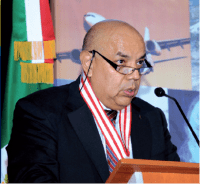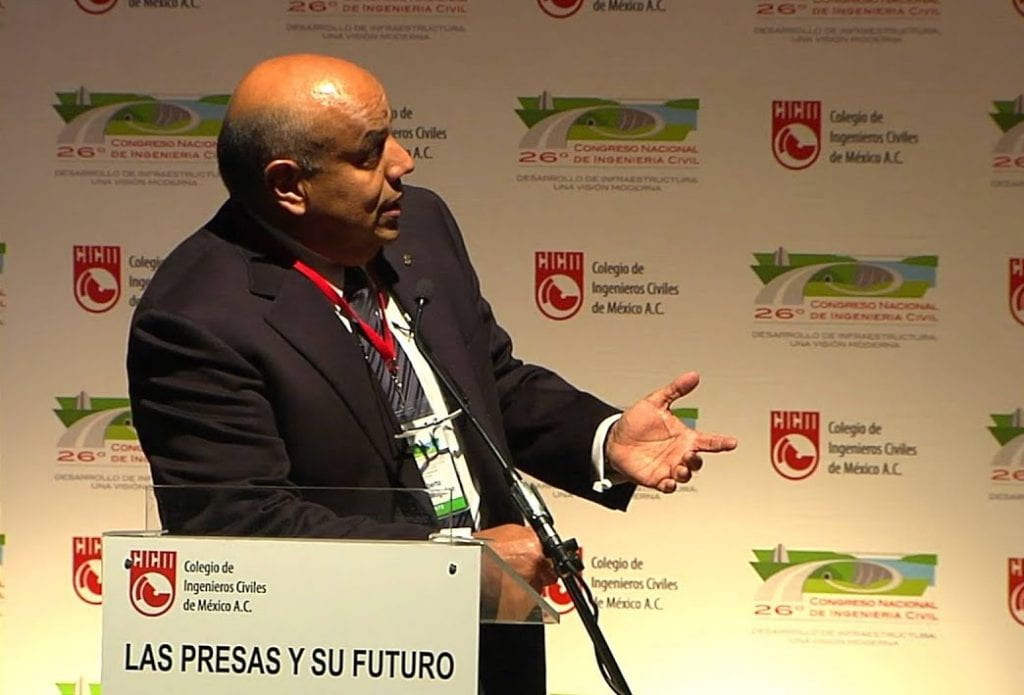Mexican Commissioner, International Boundary and Water Commission-Mexican Section
 In this issue’s Q&A, Texas+Water Editor-in-Chief, Dr. Todd Votteler, interviews Dr. Humberto Marengo, Mexican Commissioner of the International Boundary and Water Commission (IBWC)-Mexican Section.
In this issue’s Q&A, Texas+Water Editor-in-Chief, Dr. Todd Votteler, interviews Dr. Humberto Marengo, Mexican Commissioner of the International Boundary and Water Commission (IBWC)-Mexican Section.
Dr. Marengo is a civil engineer, with a master’s degree and a doctorate degree in civil engineering with a specialty in hydraulics from the Autonomous University of Mexico (UNAM). Between 1980 and 2015, Dr. Marengo was the Coordinator of Hydroelectric Projects in the Federal Commission of Electricity (CFE). He retired as the Vice Director of Projects and Construction. He was also a Professor of Engineering at UNAM and a National Researcher for the CONACYT (Science and Technology National Council) in Mexico from 1985 to 1998.
Dr. Marengo has served as the President of the Mexican Association of Hydraulics (2009 – 2011), the President of the Mexican Academy of Engineering (2012 – 2014), and President of the International Commission of Large Dams of the Americas (INCA) (2015 – 2017), and is now Mexican Committee President of the International Commission on Large Dams– (ICOLD) (Mexican Section). He has been also an independent Consultant for several hydro-projects in Ecuador, Peru and México.
What do you consider to be the most important function of the CILA?
One of the important functions of CILA is to monitor compliance with international agreements on limits and waters and explore cooperation actions for the benefit of both countries to address issues related to international waters and limits.
In this way, it is essential for CILA to avoid conflicts between the governments of Mexico and the United States as a result of issues related to the distribution of the international waters of the Rio Grande and the Colorado River and the demarcation of the international dividing line.
What aspect of your past experience do you find most valuable to you in your new role as commissioner?
My professional experience allowed me to know the quantity and distribution of surface water in the national territory, which has allowed me to understand the fundamental problems regarding water on the northern border.
Additionally, in my professional practice, I was able to design, build, and operate numerous CFE dams, among them, those that operate with sewage. I was able to implement maintenance and rehabilitation criteria for various dams, which can be applied to our hydraulic infrastructure built in previous years and propose improvements for its rehabilitation and improvement.
Finally, I have worked for more than 30 years on dam safety, both nationally and internationally, which is key for our dams and hydraulic works.
What are your main IBWC priorities for the coming years considering the challenges that climate change poses for the basins of the Colorado River and the Rio Grande?
IBWC priorities include addressing border sanitation problems in order to avoid untreated wastewater spills into the Rio Grande or the Tijuana River or untreated wastewater runoff in the populations of the land border.
Likewise, CILA seeks the modernization of water use in Mexico and the efficient use of water in a scenario of less availability, in order to ensure all uses in both countries and the fulfillment of the commitments that both countries have made concerning the Rio Grande and the Colorado River. One of the top priorities will be the reuse of wastewater on both sides of the border.
Another fundamental priority is to guarantee and improve the security of the infrastructure in charge of the IBWC, in particular of the international dams.
What are the current water conditions on the border and what role will the recent Minute 325 play in the coming months?
There is currently a serious water shortage across the border. In the Rio Grande Basin, Mexican dams are on average at 30% of their capacity, and in international dams, Mexico barely has approximately 10% of its corresponding storage. Given this, the agreements stipulated in Minute 325 will help us establish, through the development of joint models, how to use water in the most efficient and equitable way, ensuring that all users, in compliance with the treaty, have access proportional to available water.
Additionally, the Colorado River Basin has a scarcity condition that has prevailed for the last 20 years. This has led to the implementation of binational cooperation agreements to face the impacts of the shortage, such as Minute 319 and Minute 323.
Do you think that the existing agreements between Mexico and the United States provide a sufficient framework to determine how to share transboundary groundwater resources?
Definitely. The 1944 water treaty provides all the tools so that CILA can propose to the two governments all the schemes that are necessary to adapt to any circumstance that could affect compliance with the treaties. The mechanism of the Minutes provides that flexibility that otherwise would make it necessary to sign new agreements or treaties. In this sense, the existing agreements do provide an adequate framework to address any future problems that may be faced.
An example of the above is Minute 242, which establishes guidelines on the use of groundwater in the border section between Sonora and Arizona near San Luis.
What do you think will be the greatest challenges that Mexico and the United States will face during the next 20 years with respect to the water resources we share?
Undoubtedly, the biggest challenge will be to adapt to a scenario of greater water scarcity and meet all the demands of the scenario, including the treaty commitments.
Such a situation will have to lead us to innovative reuse schemes, greater efficiency in the use of water, shared uses, etc. The growth of the border population will generate extra pressure on the resource and, coupled with the above, the issue of border sanitation will continue to be an important issue in the bilateral relationship.
Spanish Translation
En la sección de preguntas y respuestas de este número, el Dr. Todd Votteler, editor en jefe de Texas+Water, entrevista al Dr. Humberto Marengo, Comisionado de la Comisión Internacional de Límites y Aguas (CILA).
El Dr. Marengo es Ingeniero Civil, con Maestría y Doctorado en Ingeniería Civil con especialidad en Hidráulica de la Universidad Autónoma de México (UNAM). Entre 1980 y 2015, el Dr. Marengo fue Coordinador de Proyectos Hidroeléctricos en la Comisión Federal de Electricidad (CFE). Se jubiló como Subdirector de Proyectos y Construcción. También fue Profesor de Ingeniería en la UNAM e Investigador Nacional por el CONACYT (Consejo Nacional de Ciencia y Tecnología) de 1985 a 1998.
El Dr. Marengo se ha desempeñado como Presidente de la Asociación Mexicana de Hidráulica (2009 – 2011), Presidente de la Academia Mexicana de Ingeniería (2012 – 2014), Presidente de la Comisión Internacional de Grandes Presas de las Americas (INCA) (2015 – 2017), y ahora es Presidente de la Asociación International de Grandes Presas–(ICOLD). También fue consultor independiente para varios proyectos hidroeléctricos en Ecuador, Perú y México.
¿Cuál considera que es la función más importante de la CILA?
Una de las funciones importantes de la CILA, es vigilar el cumplimiento de los acuerdos internacionales en materia de límites y aguas y explorar acciones de cooperación en beneficio de ambos países para atender los temas relativos a las aguas y límites internacionales.
De esta manera, para la CILA resulta fundamental evitar que existan conflictos entres los gobiernos de México y los Estados Unidos a consecuencia de tema relacionados con la distribución de las aguas internacionales de los Río Bravo y Colorado y con la demarcación de la línea divisoria internacional.
¿Qué aspecto de su experiencia considera más valioso para usted en su nuevo cargo de Comisionado?
Mi experiencia profesional, me permitió conocer la cantidad y distribución de agua superficial en el territorio nacional; lo que me ha permitido entender la problemática fundamental en materia de aguas en la frontera norte del país. Adicionalmente en mi práctica profesional, pude diseñar, construir y operar numerosas presas de la CFE, (entre ellas, aquellas que operan con aguas negras) en las que pude implementar criterios de mantenimiento y rehabilitación de varias presas, lo que se puede aplicar en nuestra actual infraestructura hidráulica y proponer mejoras para su rehabilitación.. Por último, he trabajado durante más de 30 años en materia de seguridad de presas, tanto a nivel nacional como internacional, lo cual es clave para nuestras presas y obras hidráulicas.
¿Cuáles son las principales prioridades de la CILA para los próximos años considerando los retos que significa el cambio climático para las cuencas de los ríos Colorado y Bravo?
Las prioridades de la CILA consideran la atención de los problemas fronterizos de saneamiento, a fin de evitar que existan derrames de aguas residuales sin tratar al Río Bravo, al cauce del Río Tijuana, o los escurrimientos de aguas residuales sin tratar en las poblaciones de la frontera terrestre. Igualmente, y de manera preponderante y ante un escenario de menor disponibilidad, buscar la tecnificación del uso del agua en México, el uso eficiente del aguaa fin de asegurar todos los usos en ambos países y el cumplimiento de los compromisos que ambos países tienen en el Río Bravo y en el Río Colorado. Una de las más importantes prioridades, será el reúso de aguas residuales en ambos lados de la frontera.
Otra prioridad fundamental, es garantizar y mejorar la seguridad de la infraestructura a cargo de la CILA, en particular de las Presas Internacionales.
¿Cuáles son las condiciones actuales de agua en la frontera y que papel jugará la reciente Minuta 325 en los próximos meses?
Actualmente se tiene una seria escasez de agua en toda la frontera. En la cuenca del Río Bravo las presas mexicanas se encuentran en promedio a un 30% de su capacidad y en las presas internacionales México apenas dispone de aproximadamente del 10% del almacenamiento que le corresponde. Ante ello, los acuerdos estipulados en el Acta 325 nos ayudarán a establecer, mediante el desarrollo de modelos conjuntos, como utilizar el agua de la forma más eficiente y más equitativa, asegurando que todos los usuarios incluyendo el complimiento del tratado, cuenten con un acceso proporcional al agua disponible.
Adicionalmente en la Cuenca del Río Colorado se tiene una condición de escasez que ha prevalecido los últimos 20 años. Esto ha llevado a implementar acuerdos de cooperación binacional para enfrentar los impactos de la escasez, como son el Acta 319 y el Acta 323.
¿Cree que los acuerdos existentes entre México y Estados Unidos proporcionan un marco suficiente para determinar cómo compartir los recursos de aguas subterráneas transfronterizas?
Sin duda. El tratado de aguas de 1944 proporciona todas las herramientas para que la CILA pueda proponer a los dos gobiernos todos los esquemas que se hagan necesarios para adaptarse a cualquier circunstancia que pudiera afectar el cumplimiento de los tratados. El mecanismo de las Actas, provee esa flexibilidad que en otro caso, haría necesaria la suscripción de nuevos acuerdos o tratados. En ese sentido, los acuerdos existentes si proporcionan un marco adecuado para atender cualquier problemática futura que pudiera enfrentarse.
Un ejemplo de lo anterior es el Acta de la CILA 242 que establece lineamientos sobre el uso de las aguas subterráneas en el tramo limítrofe entre Sonora y Arizona cerca de San Luis.
¿Cuáles considera que serán los mayores desafíos que enfrentarán México y Estados Unidos durante los próximos 20 años con respecto a los recursos hídricos que compartimos?
Sin lugar a dudas el mayor desafío será adaptarse a un escenario de mayor escasez de agua y el gran reto será como cubrir todas las demandas de la misma, incluyendo los compromisos del tratado bajo ese escenario. Tal situación nos tendrá que llevar a esquemas innovativos de reúso, de mayor eficiencia en el uso del agua, de compartir usos, etc. El crecimiento de la población fronteriza generará una presión extra sobre el recurso e igualmente aparejado a lo anterior, el tema del saneamiento fronterizo continuará gravitando como un tema de importancia en la relación bilateral.

